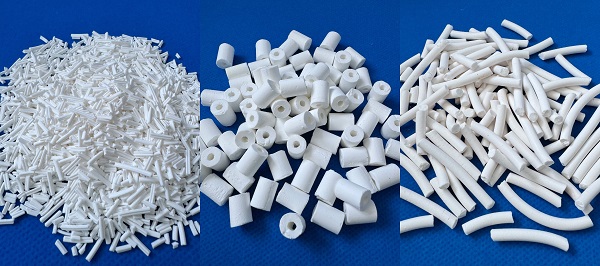ALUCAT-XR408 activated alumina catalyst carrier refers to a white solid alumina, which is the most widely used catalyst carrier, accounting for about 70% of industrial supported catalysts. Alumina has many forms, not only different forms have different properties, even the same form has different properties due to its different sources, such as density, pore structure, specific surface area, etc.
Alumina in strip, spherical, cylindrical, ring, clover-shaped and other shapes is mostly used as a catalyst carrier. Various shapes of carriers can be produced according to the customer's specific technical requirements.
Product parameters:
| Appearance | Bulk density (G/CM3) | Specific surface area (M2/G) | Pore volume (CM3/G) | compressive strength (N/颗) | NA2O % | AL2O3 % | Water absorption rate % |
| bar | 0.5-0.7 | ≥150 | ≥0.50 | ≥80 | ≤0.10 | ≥99 | ≥70 |
| Clover shape | 0.5-0.65 | 150-350 | ≥0.50 | ≥80 | ≤0.10 | ≥99 | ≥70 |
| cylindrical | 0.5-0.8 | ≥220 | ≥0.50 | ≥100 | ≤0.10 | ≥99 | ≥70 |
| Lassie Ring | 0.5-0.8 | ≥220 | ≥0.50 | ≥100 | ≤0.10 | ≥99 | ≥70 |
| spherical | ≥0.68 | ≥170 | ≥0.45 | ≥70 | ≤0.20 | ≥94 | ≥65 |
Strip-shaped, spherical, cylindrical, ring-shaped, and clover-shaped alumina are mostly used as catalyst supports, and various shapes of supports can be produced according to the specific technical requirements of customers.Classification of ALUCAT-XR408 alumina carrier:
1.γ-Al₂O₃, high specific surface area 250-400 m²/g, mainly mesoporous, used for petroleum cracking, automobile exhaust purification, and hydrodesulfurization.
2.α-Al₂O₃, low specific surface area <10 m²/g), high temperature resistance (>1000℃), used for high temperature catalysis, such as methane combustion and ammonia oxygen.
3. θ-Al₂O₃, transition state, with both thermal stability and medium specific surface area, used for Fischer-Tropsch synthesis and CO₂ hydrogenation.














